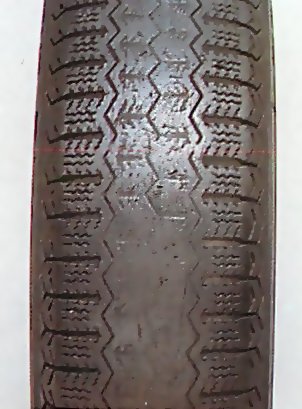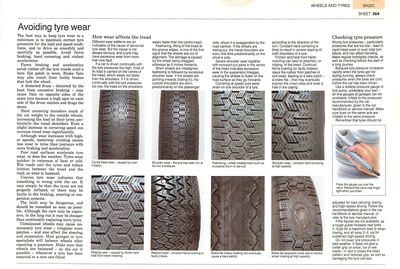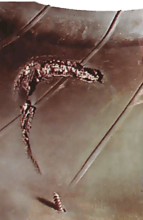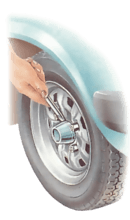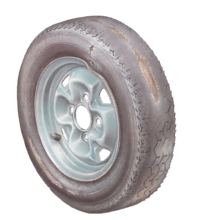The best way to keep tyre wear to a minimum is to maintain correct tyre pressures for the load and speed conditions, and to drive as smoothly and carefully as possible. Avoid fierce braking, hard cornering and violent acceleration.
Fierce braking and acceleration scrub rubber off the tyre treads until a bare flat patch is worn. Brake flats may also result from faulty brakes that lock the wheel.
A distorted drum - distorted by the heat from excessive braking - may cause flats on opposite sides of the same tyre because a high spot on each side of the drum catches and drags the shoes.
Hard cornering transfers much of the car weight to the outside wheels, increasing the load on their tyres, particularly the tread shoulders. Even a slight increase in cornering speed can increase tread wear significantly.
This video course is the best way to learn everything about cars.
Three hours of instruction available right now, and many more hours in production.
- 4K HD with full subtitles
- Complete disassembly of a sports car
Although wear increases with higher speeds, motorway cruising causes less wear to tyres than journeys with more braking and acceleration.
Poor road surfaces accelerate tyre wear, so does the weather. Tyres wear quicker in extremes of heat or cold. Wet roads cool the tyres and reduce friction between the tread and the road, so wear is lessened.
Uneven tyre wear indicates that something is wrong with the car. It may simply be that the tyres are not properly inflated, or there may be faults in the braking, steering or suspension systems.
The fault may be dangerous, and should be remedied as soon as possible. Although the cure may be expensive, in the long run it may be cheaper than continually replacing worn tyres.
Unbalanced wheels may cause unnecessary tyre wear - irregular worn patches - and also affect the steering and suspension. Most garages or tyre specialists will balance wheels after repairing a puncture. Make sure that wheels are balanced - on the car if possible - whenever a tyre has been removed or a new one fitted.
How wear affects the tread
Centre tread wear
Caused by over-inflation.
Shoulder wear
The tyre has been run at too low a pressure.
Feathering
Wheel misalignment such as excessive toe-in or toe-out.
Shoulder wear
Constant hard cornering at high speeds.
Different wear patterns are an indication of the cause of abnormal tyre wear. But the cause is not always obvious, and a tyre may have excessive wear from more than one fault.
If a car is driven continually with the tyre pressures too high, most of its load is carried on the centre of the tread, which wears out faster than the shoulders. If it is driven continually with the tyre pressures too low, the tread on the shoulders wears faster than the centre tread.
Feathering, lifting of the tread at the groove edges, is one of the first signs that the wheels are out of alignment. The damage is caused by the wheel being dragged sideways as it moves forwards.
When wheels are misaligned, feathering is followed by excessive shoulder wear. If the wheels are pointing inwards (toeing-in), the outside shoulders are worn, predominantly on the passenger side, where it is exaggerated by the road camber. If the wheels are toeing-out, the inside shoulders are worn, this time predominantly on the driver's side.
Severe shoulder wear together with scooped-out parts in the centre of the tread indicates excessive wear in the suspension linkages, causing the wheels to flutter on the road surface as they go forwards.
Ridging wear
Caused by friction and heat from harsh motoring.
Rasped tread
Constant fierce braking or faulty brakes.
Brake flat
Heavy braking will eventually cause a bare patch.
Brake flat
Exposed cords due to locked-wheel braking at high speeds.
Cornering at speed puts extra strain on one shoulder of a tyre, according to the direction of the turn. Constant hard cornering is likely to result in severe rasping of both shoulders of a tyre.
Friction and heat from harsh motoring can lead to distortion, or ridging, of the tread. Continual fierce braking (or faulty brakes) rasps the rubber from patches of tyre tread, leading to a bare patch a brake flat - that may eventually expose the crown plies and wear a hole in the casing.
Checking tyre pressure
Press the gauge cup over the valve. Replace the valve cap finger tight when you finish.
Wrong tyre pressures - particularly pressures that are too low - lead to rapid tread wear or even total tyre failure, and can affect handling. Make regular fortnightly checks, as well as checking before the start of a long journey.
Because tyre pressure increases rapidly when the tyres get hot during running, always check pressures when the tyres are cold, before the car has been driven.
Use a reliable pressure gauge or foot pump, preferably your own air-line gauges at garages can be unreliable. Inflate to the pressures recommended by the car manufacturer, given in the car handbook or service manual. Make sure tyres on the same axle are inflated to the same pressure.
Remember that tyres should be adjusted for load carrying, towing and high-speed driving. Follow the recommendations given in the car handbook or service manual, or refer to the tyre manufacturers.
If the figures are not available, as a rough guide increase rear tyres 4-6 psi for a maximum load or when towing, and all tyres 3-6 psi for sustained high-speed driving.
Do not lower tyre pressures in bad weather. It does not give a better grip on snow, ice or wet roads - in fact it closes the tread pattern and reduces grip, as well as damaging the tyre carcass.

